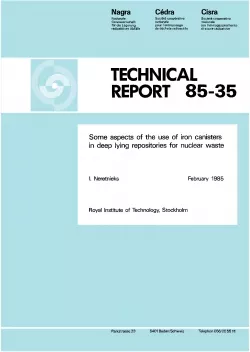
Technical Report NTB 85-35
Some aspects of the use of iron canisters in deep lying repositories for nuclear waste
Iron canisters for high level nuclear waste embedded in compacted bentonite in deep geologic repositories will corrode forming hydrogen gas. The equilibrium pressure (when corrosion would stop) has been estimated to be between 500 and 1000 atm. under repository conditions. As this is much higher than the lithostatic pressure (weight of rock overburden) the gas must be allowed to escape before it disrupts the repository. Escape by diffusion alone is not sufficient but recent experiments (Pusch 1984) have demonstrated that the larger pores in the bentonite are blown free of water and let the gas escape before excessive pressures build up.
The potential effect of a capillary breaking layer (CBL) has been explored. A fine layer nearest the canister (e.g. quartz sand) would have much lower capillary suction pressures than the bentonite clay. Hydrogen gas formed by corrosion would drive out water from this layer. The gas/water interface would stabilize at the CBL-bentonite interface. The water cannot be driven out of the bentonite (except from the very largest pores) because of the very high suction pressures. When there is no water in contact with the iron, corrosion will slow down considerably. A steady-state corrosion rate will be reached. Due to lack of data at present the steady-state pressure and corrosion rate cannot be quantified but is entirely conceivable that it will decrease by several orders of magnitude below that when water is freely available. If this occurs then an additional effect may be expected. As long as the CBL is void of liquid water no radionuclides can escape, even if the canister is penetrated.
